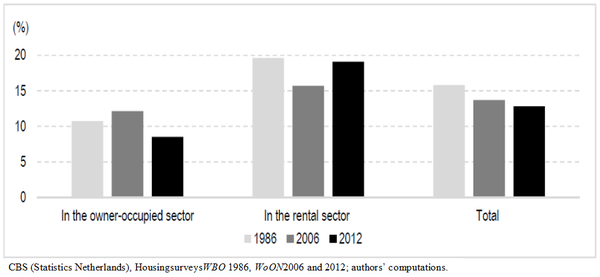Economie et Statistique / Economics and Statistics n° 500-501-502 - 2018 The dynamisation and subsequent vulnerability of the Dutch owner-occupied sector. An analysis of 1986-2012
THE ARTICLE ON ONE PAGE
Key question
There is a general assumption that housing careers of contemporary Dutch owner-occupiers involve more residential moves than three decades ago.At the same time, more older people in the sector might negatively affect overall residential mobility. How did behavioural and compositional factors affect residential mobility in the Dutch owner-occupied sector? Did the dynamisation of the sector make it more vulnerable to an economic crisis?
Methodology
Based on cross sectional data from the Dutch Housing Survey,an “Oaxaca-Blinder” decomposition is used to disentangle behavioural and compositional effects on changes in residential mobility between 1986 and 2006, then a regression method is used to investigate the impact of the crisis.
Main results
- The percentage of recently moved owner-occupier households has increased from 10.7% in 1986 to 12.1% in 2006. After the crisis, it has declined to 8.5% in 2012.
- The decomposition shows that the change in observed mobility from 1986 to 2006in the owner-occupied sector (+1.4 pct point)wasmostly driven by a change in behaviours: households have become more mobile (+3.6 pct points), with the highest increase among the youngest; the compositional effect, mainly due to the ageing process, is negative.
- Households enter the owner-occupied sector at a younger age. Young owner-occupiers have become much more dynamic and moved more frequently under the favourable economic circumstances of the 1980s until around 2005. This dynamism abruptly halts with the crisis. Especially when they are highly leveraged, the next move on the housing ladder is often obstructed by the decline in house prices.
- Low-income owner-occupierswere not so much impacted in their mobility by the crisis of 2008-2013. These households are often first time buyers who may have benefited from declining house prices.
graphiqueHouseholds that recently moved (in the two previous years)

Main message
The analysis gives more empirical substance to the general assumption that Dutch owner-occupiers have become more mobile over time. There is consensus that the “dynamic” Dutch owner-occupied sector is vulnerable to a crisis. This research shows that the presence of more young, dynamic households in the owner-occupied sector contributes also to this vulnerability. This may lead to reflection on public policies that have focused on home ownership among a broad layer of society.
Article on one page (pdf, 180 Ko )



